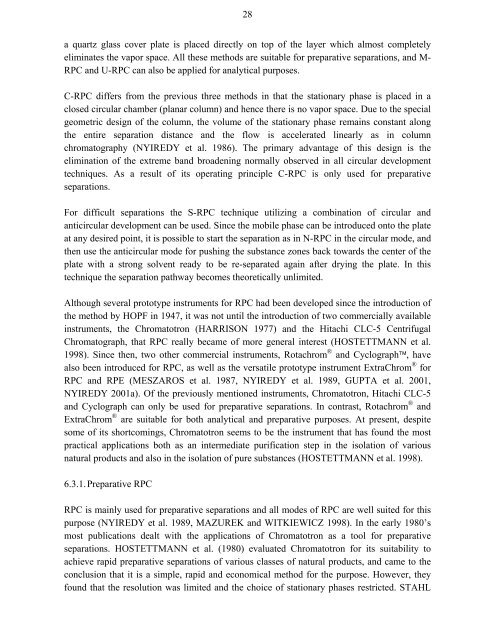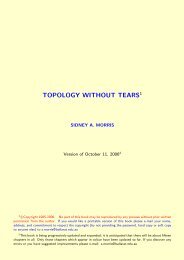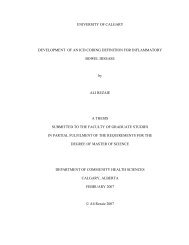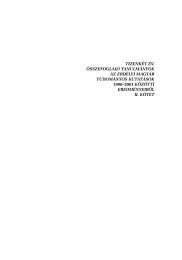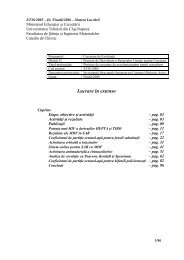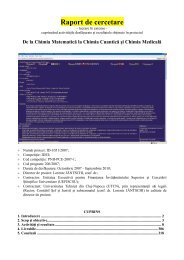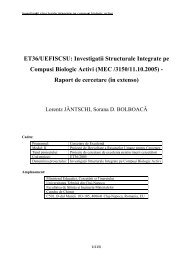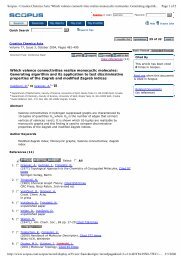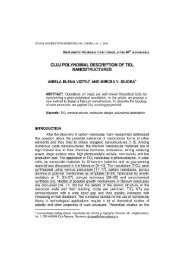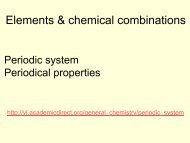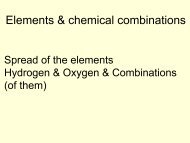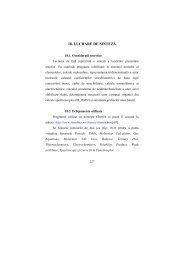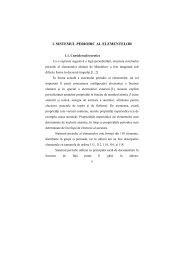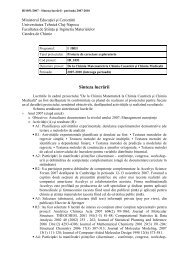Extraction and Planar Chromatographic Separation Techniques in the
Extraction and Planar Chromatographic Separation Techniques in the
Extraction and Planar Chromatographic Separation Techniques in the
Create successful ePaper yourself
Turn your PDF publications into a flip-book with our unique Google optimized e-Paper software.
28<br />
a quartz glass cover plate is placed directly on top of <strong>the</strong> layer which almost completely<br />
elim<strong>in</strong>ates <strong>the</strong> vapor space. All <strong>the</strong>se methods are suitable for preparative separations, <strong>and</strong> M-<br />
RPC <strong>and</strong> U-RPC can also be applied for analytical purposes.<br />
C-RPC differs from <strong>the</strong> previous three methods <strong>in</strong> that <strong>the</strong> stationary phase is placed <strong>in</strong> a<br />
closed circular chamber (planar column) <strong>and</strong> hence <strong>the</strong>re is no vapor space. Due to <strong>the</strong> special<br />
geometric design of <strong>the</strong> column, <strong>the</strong> volume of <strong>the</strong> stationary phase rema<strong>in</strong>s constant along<br />
<strong>the</strong> entire separation distance <strong>and</strong> <strong>the</strong> flow is accelerated l<strong>in</strong>early as <strong>in</strong> column<br />
chromatography (NYIREDY et al. 1986). The primary advantage of this design is <strong>the</strong><br />
elim<strong>in</strong>ation of <strong>the</strong> extreme b<strong>and</strong> broaden<strong>in</strong>g normally observed <strong>in</strong> all circular development<br />
techniques. As a result of its operat<strong>in</strong>g pr<strong>in</strong>ciple C-RPC is only used for preparative<br />
separations.<br />
For difficult separations <strong>the</strong> S-RPC technique utiliz<strong>in</strong>g a comb<strong>in</strong>ation of circular <strong>and</strong><br />
anticircular development can be used. S<strong>in</strong>ce <strong>the</strong> mobile phase can be <strong>in</strong>troduced onto <strong>the</strong> plate<br />
at any desired po<strong>in</strong>t, it is possible to start <strong>the</strong> separation as <strong>in</strong> N-RPC <strong>in</strong> <strong>the</strong> circular mode, <strong>and</strong><br />
<strong>the</strong>n use <strong>the</strong> anticircular mode for push<strong>in</strong>g <strong>the</strong> substance zones back towards <strong>the</strong> center of <strong>the</strong><br />
plate with a strong solvent ready to be re-separated aga<strong>in</strong> after dry<strong>in</strong>g <strong>the</strong> plate. In this<br />
technique <strong>the</strong> separation pathway becomes <strong>the</strong>oretically unlimited.<br />
Although several prototype <strong>in</strong>struments for RPC had been developed s<strong>in</strong>ce <strong>the</strong> <strong>in</strong>troduction of<br />
<strong>the</strong> method by HOPF <strong>in</strong> 1947, it was not until <strong>the</strong> <strong>in</strong>troduction of two commercially available<br />
<strong>in</strong>struments, <strong>the</strong> Chromatotron (HARRISON 1977) <strong>and</strong> <strong>the</strong> Hitachi CLC-5 Centrifugal<br />
Chromatograph, that RPC really became of more general <strong>in</strong>terest (HOSTETTMANN et al.<br />
1998). S<strong>in</strong>ce <strong>the</strong>n, two o<strong>the</strong>r commercial <strong>in</strong>struments, Rotachrom ® <strong>and</strong> Cyclograph, have<br />
also been <strong>in</strong>troduced for RPC, as well as <strong>the</strong> versatile prototype <strong>in</strong>strument ExtraChrom ® for<br />
RPC <strong>and</strong> RPE (MESZAROS et al. 1987, NYIREDY et al. 1989, GUPTA et al. 2001,<br />
NYIREDY 2001a). Of <strong>the</strong> previously mentioned <strong>in</strong>struments, Chromatotron, Hitachi CLC-5<br />
<strong>and</strong> Cyclograph can only be used for preparative separations. In contrast, Rotachrom ® <strong>and</strong><br />
ExtraChrom ® are suitable for both analytical <strong>and</strong> preparative purposes. At present, despite<br />
some of its shortcom<strong>in</strong>gs, Chromatotron seems to be <strong>the</strong> <strong>in</strong>strument that has found <strong>the</strong> most<br />
practical applications both as an <strong>in</strong>termediate purification step <strong>in</strong> <strong>the</strong> isolation of various<br />
natural products <strong>and</strong> also <strong>in</strong> <strong>the</strong> isolation of pure substances (HOSTETTMANN et al. 1998).<br />
6.3.1.Preparative RPC<br />
RPC is ma<strong>in</strong>ly used for preparative separations <strong>and</strong> all modes of RPC are well suited for this<br />
purpose (NYIREDY et al. 1989, MAZUREK <strong>and</strong> WITKIEWICZ 1998). In <strong>the</strong> early 1980’s<br />
most publications dealt with <strong>the</strong> applications of Chromatotron as a tool for preparative<br />
separations. HOSTETTMANN et al. (1980) evaluated Chromatotron for its suitability to<br />
achieve rapid preparative separations of various classes of natural products, <strong>and</strong> came to <strong>the</strong><br />
conclusion that it is a simple, rapid <strong>and</strong> economical method for <strong>the</strong> purpose. However, <strong>the</strong>y<br />
found that <strong>the</strong> resolution was limited <strong>and</strong> <strong>the</strong> choice of stationary phases restricted. STAHL


